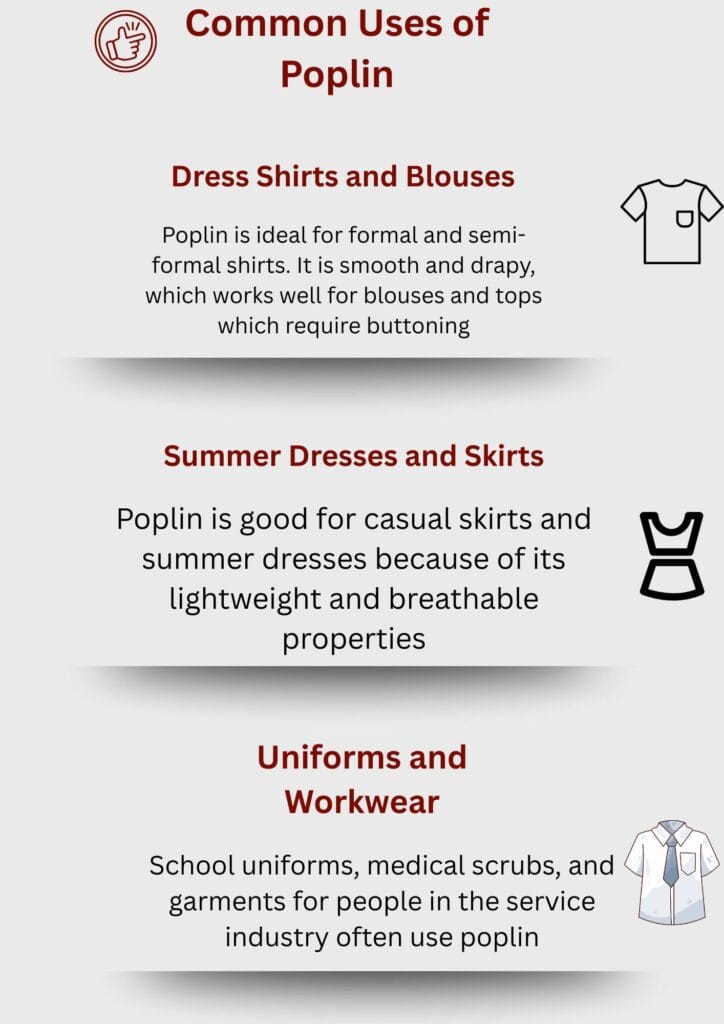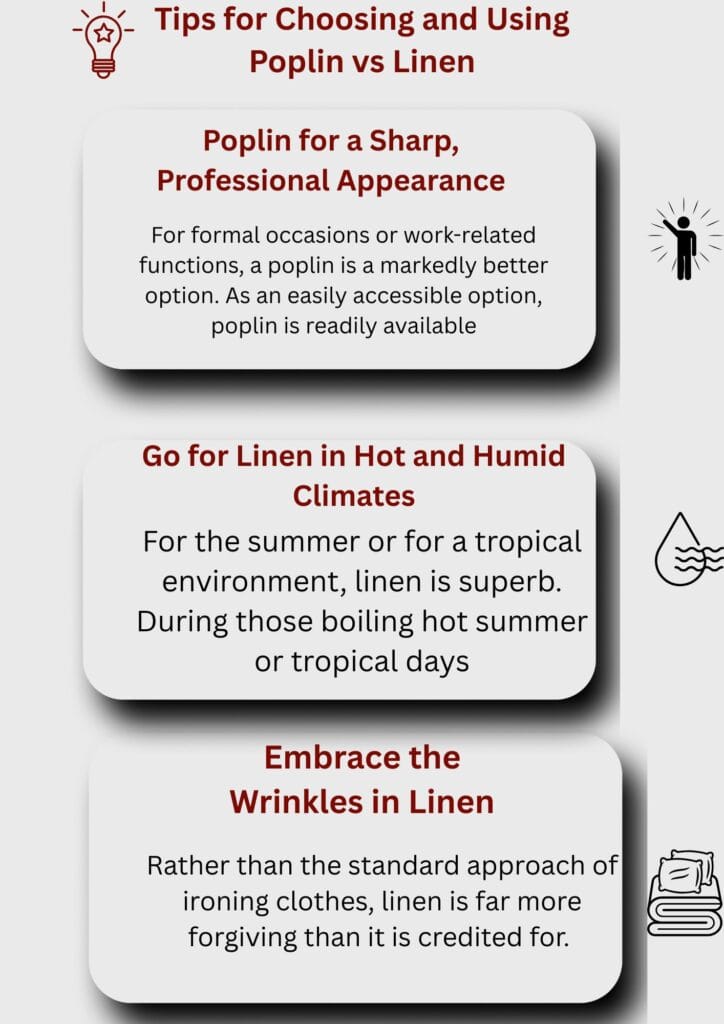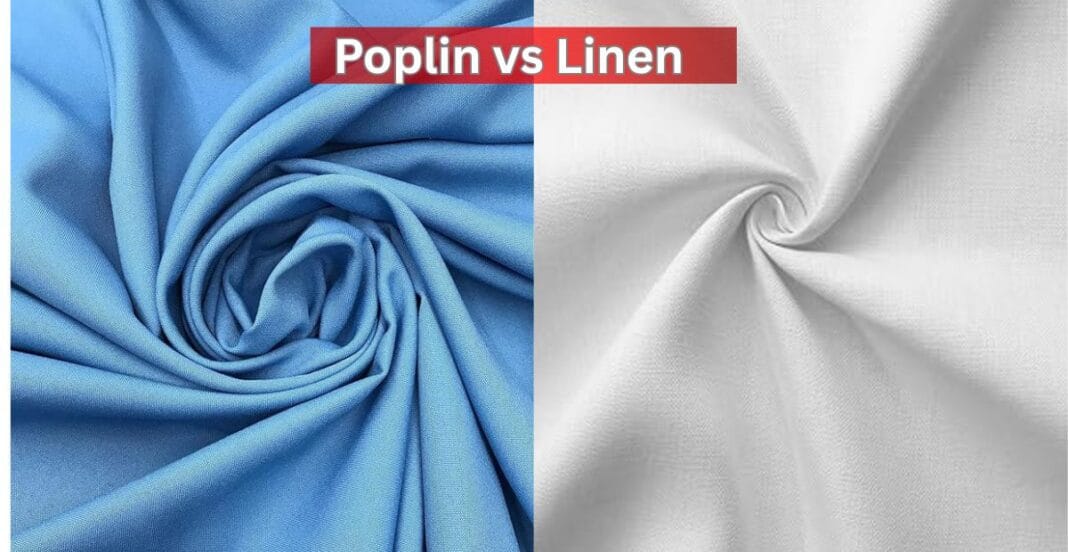Introduction
In the world of textiles, both poplin and linen hold great historical significance. Poplin is recognized for its smooth texture and linen for its loose and breathable character.
Knowing their differences is helpful for selecting the best material for clothing, upholstery, or even DIY projects. The opposing traits of both poplin and linen justify the need to consider relevant comparisons for comfort and style.
Also, the performance of the fabric differs with the season, sensitivity of the skin, and the preferred method of care. Understanding the performance of each fabric can help save money and time.
Overview of Poplin Fabric
Definition & Composition
Traditionally, poplin was a cotton fabric but today is mostly is a blend of cotton and polyester or elastane. Poplin is a plain woven fabric with a tight and crisp weave with thin horizontal ribs.
The blend improves its structure, adds durability, and sometimes even provides a slight sheen. In stores, you can find both the 100% cotton poplins and the polyester-cotton blends.
The fabric maintains its shape through natural contouring and resists wrinkling better than many, yet remains more resilient than natural varieties, including cotton.
Common Uses of Poplin

Dress Shirts and Blouses
Poplin is ideal for formal and semi-formal shirts. It is smooth and drapy, which works well for blouses and tops which require buttoning. With poplin shirts, one always has a well-groomed and professional look for work and for any occasion.
Summer Dresses and Skirts
Poplin is good for casual skirts and summer dresses because of its lightweight and breathable properties. It has the ability to retain its shape which results in flattering cuts and graceful lines. Summer collections often feature poplin in floral prints or pastel colors.
Uniforms and Workwear
School uniforms, medical scrubs, and garments for people in the service industry often use poplin. For everyday wear, poplin’s durability, low upkeep, and crisp appearance is advantageous. It also has low wrinkle ability which helps uniforms maintain a neat appearance during long shifts.
Crafting and Sewing Projects
In the crafting and DIY world, poplin is also a favorite. It can be easily cut, sewn, and pressed, which is ideal for quilting and making custom accessories such as aprons and tote bags. Smooth fabrics, and poplin in particular, are great for printing and embroidering.
Home Textiles and Décor
Though less common, poplin is at times utilized in such home décor goods as lightweight curtains, pillows, and various ornamental accents. Its muted gleam enhances elegance in poplin, especially when the décor is modern and minimalistic.
Overview of Linen Fabric
Definition and Composition
Linen is a fabric produced from flax plant’s fibers. Linen, unlike synthetic and blended fabrics, is 100 biodegradable and purely plant-based.
The weaving preserves its structure to be a little rough, yet porous. Those eco-friendly attributes attract consumers who care about sustainability.
Characteristics of Linen
Linen is best known for its breathability and moisture-wicking abilities. In hot and humid weather, it is comfortable to wear and keeps the body dry.
The lack of elasticity makes it wrinkle more easily. The rustic, weathered look from the textured weave is charming and appealing.
Common Uses of Linen
Linen is a top choice for:
- Apparel including shirts, dresses, and pants
- Bedding items, including light pillow covers and sheets
- Drapery and casual table linens
Warm season clothing and minimalist designs for the home are where it is most commonly used.
Poplin vs Linen: Head-to-Head Comparisons
Breathability: Linen Wins Hot Weather
Linen has a looser weave that enables better air circulation because of the natural fibers that it is made from. This makes it favorable during the summer and in tropical regions.
Although poplin is breathable, it is less favorable during spring and early fall as it is more suitable during these times. This is because it is made from tighter weaves and synthetic materials that it traps heat.
Durability: Poplin Lasts Longer
Poplin is more durable, especially in blends with polyester. It resists tearing, fraying, and excessive wear over time.
Linen softens with every wash but may become thin or worn if not handled carefully.
Wrinkling: Poplin Resists; Linen Embraces
Poplin is perfect for office wear or travel as it retains its shape and does not accumulate wrinkles.
Linen, on the other hand is easy to wrinkle, but the crinkled look is attractive in casual wear.
Texture: Smooth Poplin vs Textured Linen
Poplin is preferred for formal attire as it is almost silky and smooth with a clean finish.
Having a textured surface, linen has slubs which are lumps of natural fibers that are more attractive and give it a handwoven impression.
Care and Maintenance
Poplin is low maintenance as it is machine-washable and dries quickly. It only requires ironing for very formal garments.
Linen is a delicate fabric. While some people prefer leaving it un-ironed, others smoothen it out using a hot iron. If washed incorrectly, it has the potential to shrink.
Cost Comparison: Linen is Pricier
Linen is deemed to be more expensive when compared to other materials due to the rigorous process it undergoes for production. It is often regarded as luxury fabric.
Linen is often considered as luxury fabric. For blended versions, poplin is more affordable and readily accessible which makes it attractive for budget-conscience shoppers.
Eco-Friendliness: Linen Leads
Linen stands out as a more environmentally friendly product. It is sustainable, biodegradable, and requires less water to produce when compared to cotton. It is more eco-friendly in comparison to other fabrics.
The eco-friendliness of poplin varies according to its composition. It is more sustainable than versions that contain polyester. Organic cotton poplin is less sustainable than its counterparts.
Best Uses for Each Fabric: Choosing Based on Needs
Choose Poplin If You Want Structure and Polish
Poplin excels in areas that require sharp and clean aesthetic. For example:
- Office meetings
- Business presentations
- School uniforms
- Semi-formal gatherings
Poplin’s neat drape and resistance to wrinkling fabric is beneficial in these roles.
Choose Linen If You Prefer Comfort and Casual Style
Linen is perfect for relaxed occasions as well as warm climates. Select linen for:
- Traveling
- Attending casual or outdoor events
- Breathable loungewear
- Rustic home décor
With its laid-back charm, linen is an essential for summer decor.
Embracing Linen’s Wrinkles For A Casual Vibe
Linen looks best when it is worn loosely and is flowing. For best results, wear dull, soft pastel earth toned linen that is paired with sandals or canvas sneakers.
Linen is dressy when worn oversized, in the form of oversized shirts and drawstring pants or wrap dresses.
A co-ord set or a linen jacket complements casual outfits while ensuring breathability.
Tips for Choosing and Using Poplin vs Linen

Poplin for a Sharp, Professional Appearance
For formal occasions or work-related functions, a poplin is a markedly better option. As an easily accessible option, poplin is readily available and is preffered due the its crisp structure and wrinkle reistant features that make it ideal for dress shirts, fitted dresses and even for uniforms.
Tip: Solid colored poplin shirts in white, navy or pastel shades retain a timeless appeal and are always in style.
Go for Linen in Hot and Humid Climates
For the summer or for a tropical environment, linen is superb. During those boiling hot summer or tropical days, it allows for superior breathability due to its loose weave, making it the ideal top choice for a hot temperature.
Tip: Loose fitting linen will allow for better airflow, be more comfortable and reduce the visibility of wrinkles.
Embrace the Wrinkles in Linen
Rather than the standard approach of ironing clothes, linen is far more forgiving than it is credited for. Linen is known for its carefree appeal and looks which is not preffered by majority of the fashion crowd. The charm it imbues is unparalleled and gives off a laid back approach.
Tip: The less conventional approach of not ironing but lightly spritzing linen will result in far better outcomes, allowing the garment to air dry to reduce wrinkles.
Use Poplin for Projects That Need Structure
If you are into sewing or already have a few different crafty projects underway, poplin will be a dream. Due to poplin being easily accessible, it can easily be cut and sewn, can hold prints beautifully and does not shift stiching.Consider using poplin for sturdy quilt blocks, aprons, tote bags, or other do-it-yourself projects that require a firm structure.
Conclusion
Linen and poplin both have their unique characteristics that serve different purposes.
For those that require a more structured, wrinkle-free, and refined appearance, poplin is the fabric of choice. Ideal for workwear, uniforms, and formal dressing.
Choose linen if you want something breathable and comfortable with an organic look. It is ideal for summer clothing, relaxed days, and eco-friendly living.
As always, make your choice based on your lifestyle, surroundings, and your fashion objectives. For numerous individuals having both materials in your wardrobe presents the option to be ready for any occasion is the most convenient.
FAQs
Is Poplin Cooler Than Linen?
Poplin, on the other hand, is able to breathe to some degree, however, the fabric’s tighter weave makes it susceptible to retaining heat.


